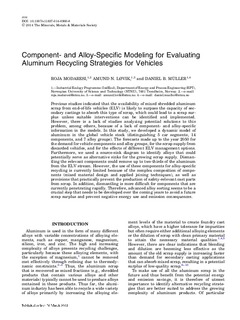Component- and Alloy-Specific Modeling for Evaluating Aluminum Recycling Strategies for Vehicles
Journal article, Peer reviewed
Permanent lenke
http://hdl.handle.net/11250/2392269Utgivelsesdato
2014Metadata
Vis full innførselSamlinger
Sammendrag
Previous studies indicated that the availability of mixed shredded aluminum
scrap from end-of-life vehicles (ELV) is likely to surpass the capacity of secondary
castings to absorb this type of scrap, which could lead to a scrap surplus
unless suitable interventions can be identified and implemented.
However, there is a lack of studies analyzing potential solutions to this
problem, among others, because of a lack of component- and alloy-specific
information in the models. In this study, we developed a dynamic model of
aluminum in the global vehicle stock (distinguishing 5 car segments, 14
components, and 7 alloy groups). The forecasts made up to the year 2050 for
the demand for vehicle components and alloy groups, for the scrap supply from
discarded vehicles, and for the effects of different ELV management options.
Furthermore, we used a source-sink diagram to identify alloys that could
potentially serve as alternative sinks for the growing scrap supply. Dismantling
the relevant components could remove up to two-thirds of the aluminum
from the ELV stream. However, the use of these components for alloy-specific
recycling is currently limited because of the complex composition of components
(mixed material design and applied joining techniques), as well as
provisions that practically prevent the production of safety-relevant cast parts
from scrap. In addition, dismantling is more difficult for components that are
currently penetrating rapidly. Therefore, advanced alloy sorting seems to be a
crucial step that needs to be developed over the coming years to avoid a future
scrap surplus and prevent negative energy use and emission consequences.
